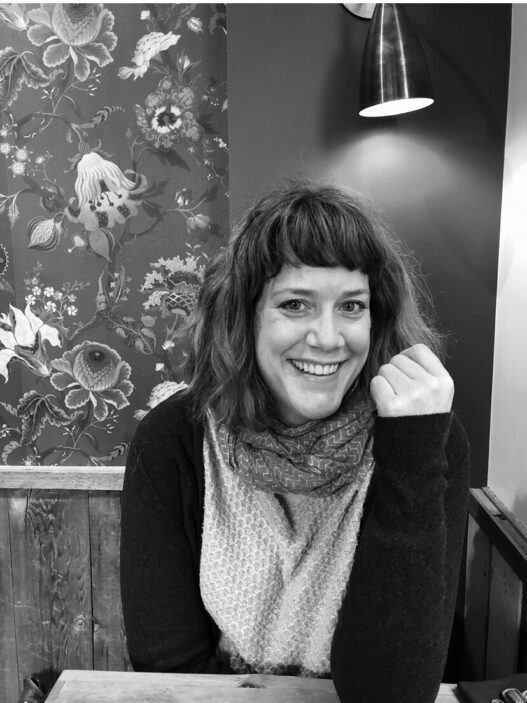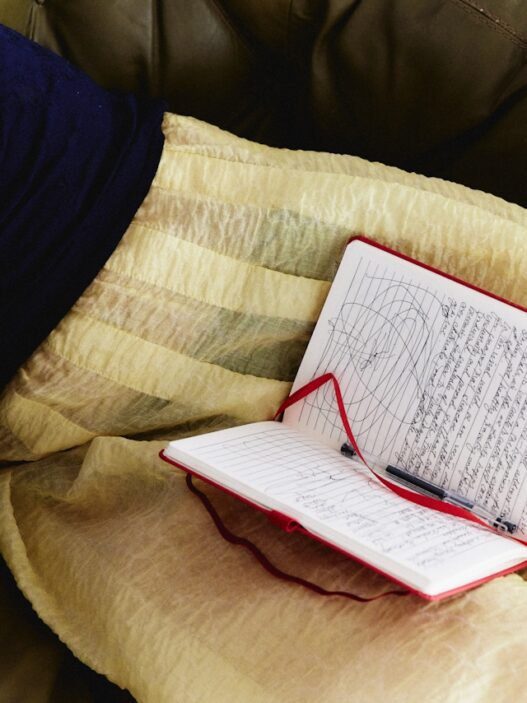This Is Not a Hobby
DIY isn’t just crafting, and it’s not a passive past time either — it’s opting out of mass production, capitalist sameness, and gatekept expertise. It’s a mode of survival, a creative language, a political strategy, and a deeply personal lifestyle.
Whether you’re mending your jeans, printing your own zines, or building a mutual aid pantry, DIY is about more than what you make — it’s about how you live, resist, and relate. It is — and always has been — political.
There is no such thing as apolitical creativity. When we talk about DIY, we’re not just talking about paint swatches and Pinterest boards — we’re talking about an alternative economy of knowledge. A living archive of resistance. A way of saying, “I will not disappear.”
To say that DIY is “just for fun” is to ignore the centuries of survival-based making by women, queer folks, racialized communities, and working-class people. Sewing your own clothes wasn’t an aesthetic choice for your great-grandmother — it was an economic necessity. Making zines wasn’t a quirky teen phase for 90s riot grrrls — it was the only way to be heard when mainstream media shut them out.
When the world is built to reward obedience, doing things yourself becomes a radical act of refusal.
DIY Isn’t Just Political — It’s Tactical
Capitalism depends on our incompetence and modern consumer culture is designed to make you feel helpless. You don’t know how to fix your phone, sew a button, or grow your own herbs — and that’s not by accident. There’s an entire economy built on outsourcing your basic needs and lack of independence and self-sufficiency to corporations.
The less we know, the more we buy.
Unlike much of what capitalism offers, DIY doesn’t rely on artificial scarcity. It thrives on abundance — of knowledge, of community, of imperfection, of shared skill.
Capitalism thrives on scarcity and comparison. There’s never enough: not enough time, talent, money, or success to go around.
DIY culture doesn’t play that game.
Look closely, and you’ll see DIY as a strategy of reclamation.
It reclaims time from productivity culture. It reclaims space from sterile, commercial design. It reclaims voice from filtered feeds and brand templates. It reclaims worth from an economy that only values what can be scaled, sold, or trademarked.
It’s not just about anti-capitalism — although that’s a big part of it. It’s about autonomy in a culture that is constantly trying to collapse your options into “buy or disappear.” DIY insists on a third way: make it yourself. Learn it yourself. Pass it on.
It says: you don’t need to wait for permission. You don’t need to be an expert. You can try. It might be messy, but it’s yours. The minute you choose making over purchasing, learning over scrolling, skill-building over quick fixes — you become harder to manipulate.
You become sovereign.
One of the most powerful things about DIY is that it decentralizes knowledge. Anyone can enter. Anyone can contribute.
Skill-Sharing as Counter-Infrastructure
DIY communities are built on exchange — not extraction.
Skill-sharing is more than a nice idea; it’s a structural alternative to capitalist hoarding. Where corporations monetize expertise and limit access, DIY communities make it accessible, peer-to-peer, and often free.
YouTube tutorials, community workshops, TikTok hacks, and skillshares are the new universities. Zines become textbooks. Discord servers become studios. Your grandmother becomes your professor.
Think about tool libraries, sewing bees, co-op studios, and public makerspaces. These aren’t side projects — they’re shadow infrastructures, quietly building a world in which people have the skills and tools to survive together.
This redistribution of knowledge is powerful — and threatening to systems that rely on the scarcity of expertise. When we teach each other how to make things — how to fix, build, organize, resist — we disrupt hierarchies of value and reclaim what’s always been ours.
Across the globe, we’re seeing the rise of mutual aid repair cafes, community print studios, underground costume co-ops, and post-capitalist design collectives. These are the soft revolutions — the ones made of duct tape and stubbornness and spreadsheets run by volunteers.
They are imperfect. They are alive. They are working.

When Making Becomes Mutual Aid
At its core, DIY is relational. It thrives not in isolation, but in exchange.
That mended coat you give your neighbour, the zines you leave in free boxes, the bulk-bought embroidery floss you share with a friend — sure, these are gifts. But they’re also a refusal of the capitalist logic that says everything must be monetized to matter.
Making becomes mutual aid when it meets a need. When it feeds someone. Warms someone. Uplifts someone.
The DIY world is generous by design. Skillsharing. Free patterns. Open-source code. Zine libraries. Tool banks. Collectives. Time banks. Workshops that are pay-what-you-can.
Because the point isn’t to outdo — it’s to outlast.
Community, not Competition.
When you host a crafternoon, trade handmade gifts, teach a friend to use a sewing machine, or sell your art at a sliding scale, you’re rejecting the lie that we’re each on our own.
In this way, DIY transcends aesthetics. It becomes kinship work. It becomes survival. It becomes care. And care is radical.
Reclaiming the Domestic Sphere as a Site of Power
For centuries, the domestic was dismissed — coded as feminine, soft, unimportant. But the kitchen table has always been a site of innovation and resistance.
From handwritten recipes passed down in exile, to sewing circles as spaces for organizing, the domestic isn’t apolitical — it’s heavily policed because of its power.
DIY transforms that space into a site of possibility.
When you brew herbal remedies on your stove, you’re tapping into centuries of plant knowledge that predates big pharma. When you mend your clothes instead of buying new ones, you’re rejecting fast fashion’s environmental devastation. When you build a bookcase from reclaimed wood instead of ordering one off Amazon, you’re resisting convenience culture in favour of something slow, intentional, and rooted in care.
It’s not just homemaking — it’s remaking home.
DIY Is Ancestral, Not Trendy
Let’s be clear: DIY culture didn’t start with Etsy. Or Instagram. Or whatever rebranded version of “handmade” you last scrolled past.
It has roots far deeper.
It comes from Black quilting circles that sewed resistance into symbols. From Indigenous beadworkers keeping traditions alive under the weight of colonial erasure. From punk kids in basements cutting and pasting manifestos between sets. From working-class grandmothers who could stretch a spool of thread for miles. From refugees who learned to build homes from what others left behind.
It comes from necessity, from resourcefulness, from care, from rage.
And yes — it comes from joy, too. From the thrill of creation. From sharing tools. From passing knowledge hand-to-hand, generation to generation.
To pretend DIY is a new aesthetic trend is to erase that lineage. To forget that handmade culture has always been about more than glue guns and grainy filters — it’s been about keeping going when no one else gave a shit.
The Myth of the ‘Creative Type’
One of capitalism’s most enduring lies is that creativity is a rare gift bestowed upon a select few.
The myth of the “creative type” is weaponized to keep us consuming. If you don’t think of yourself as creative, you’re more likely to outsource your imagination. You buy art you could make. You purchase ideas already watered down for mass appeal. You let someone else define what’s beautiful, useful, or worthy of attention.
DIY explodes that myth.
It says creativity isn’t rare — it’s systemically suppressed. And when you tap into it — even clumsily — you begin to dismantle one of capitalism’s most powerful illusions: that your job is to consume, not to create.

The Emotional Politics of Making
DIY isn’t just physical labour — it’s emotional labour, too.
There’s grief in unlearning the belief that you’re not creative. There’s vulnerability in sharing something handmade. There’s power in making beauty from chaos — especially when the world is falling apart.
When you embroider your rage into a patch, or press your grief into a collage, or write a zine about your breakup, you’re practicing emotional survival. You’re making meaning from the pieces. You’re choosing expression over repression.
That’s not frivolous. That’s not a distraction. That’s therapy capitalism can’t monetize — and that’s why it’s threatening.
The Problem With Aesthetic-Only DIY
DIY doesn’t become radical just because it’s handmade.
When we treat DIY as just another visual category — something curated for feeds, optimized for clicks, or stripped of its context — we risk turning it into everything it was meant to resist.
Real DIY isn’t sterile. It’s messy. Rough-edged. Politically informed. It doesn’t always match. It doesn’t always sell.
But it’s honest.
Pretty doesn’t equal powerful. And centring only palatable, marketable makers (read: often white, cis, thin, able-bodied, and middle class) replicates the same hierarchies we claim to dismantle.
If your DIY world is missing elders, missing stories from the margins, missing critique — it’s not resistance. It’s just content.
The Politics of Time
One of the most radical things about DIY is that it takes time — and refuses to apologize for it.
In a world obsessed with efficiency, anything that requires slowness is framed as wasteful. But slowness is resistance. Patience is power.
When you spend an hour unpicking stitches instead of tossing a shirt in the garbage, you’re defying a system that says your time is better spent shopping. When you spend two days hand-making protest signs instead of using a Canva template, you’re reclaiming your timeline from automation. When you grow herbs instead of clicking “add to cart,” you’re rejecting the false urgency of convenience.
DIY isn’t slow because it’s inefficient — it’s slow because it honours process over profit.

the Myth of the Solitary Genius
The image of the lone artist — tortured, isolated, brilliant — is not only inaccurate, it’s harmful.
It erases the collective nature of creativity. The fact that we learn from each other, rely on each other, build on each other’s mistakes and insights.
If the early language of DIY was “do it yourself,” the next chapter is “do it together.”
DIY culture doesn’t need to be solitary. In fact, it never really was.
The shift from DIY to DIT — Do It Together — acknowledges that community is core to sustainability. Makerspaces, community kitchens, fibre arts collectives, tool libraries, and radical publishing hubs all operate on this principle.
It’s about autonomy and connection.
DIY culture replaces the myth of the genius with the truth of the crew. The zine distro. The band. The potluck. The skillshare. The group chat. The late-night sewing circle where ideas get stitched into being between gossip and tea.
You can self-publish your zine and trade with others. You can learn to build a shelf and teach someone else to do it. You can knit, code, mend, sculpt, or print with people.
You don’t need to be exceptional. You need to be in community.
And that’s what terrifies systems built on individualism: that we might remember how much we need each other.
DIT — Do It Together — means we don’t have to hold it all alone. And that collective energy? That’s what keeps movements alive.
So, What Now?
Make something that matters — even if it’s weird. Especially if it’s weird.
→ Mend your clothes in public.
→ Write a zine about something no one else will say out loud.
→ Learn a skill and teach it to a neighbour.
→ Grow something, anything, even if it dies.
→ Build a shelf.
→ Make your own holiday.
→ Cook for someone who didn’t ask.
→ Craft a spell out of garbage.
→ Host a workshop even if you feel unqualified.
→ Refuse to disappear.
Because when you make meaning with your own two hands — meaning that isn’t sold to you, sponsored by anyone, or engineered for your feed — that’s resistance.
That’s DIY.
And it’s never been more necessary.

Want to keep building the resistance?
→ Subscribe to our newsletter for creative tools, DIY guides, and subversive skill-building.
→ Tag your projects with #newgirlarmy
→ Pitch your own story for She Zine Mag.
→ Share your resources with us and we’ll list them on the site.

AXO (she/her) is a multidisciplinary creator, editor, and builder of feminist media ecosystems based in Toronto. She is the founder of She Zine Mag, Side Project Distro, BBLGM Club, and several other projects under the AXO&Co umbrella — each rooted in DIY culture, creative rebellion, and community care. Her work explores the intersection of craft, technology, and consciousness, with an emphasis on handmade ethics, neurodivergent creativity, and the politics of making. She is an advocate for accessible creativity and the power of small-scale cultural production to spark social change. Her practice merges punk, print, and digital media while refusing to separate the emotional from the practical. Above all, her work invites others to build creative lives that are thoughtful, defiant, and deeply handmade.


























